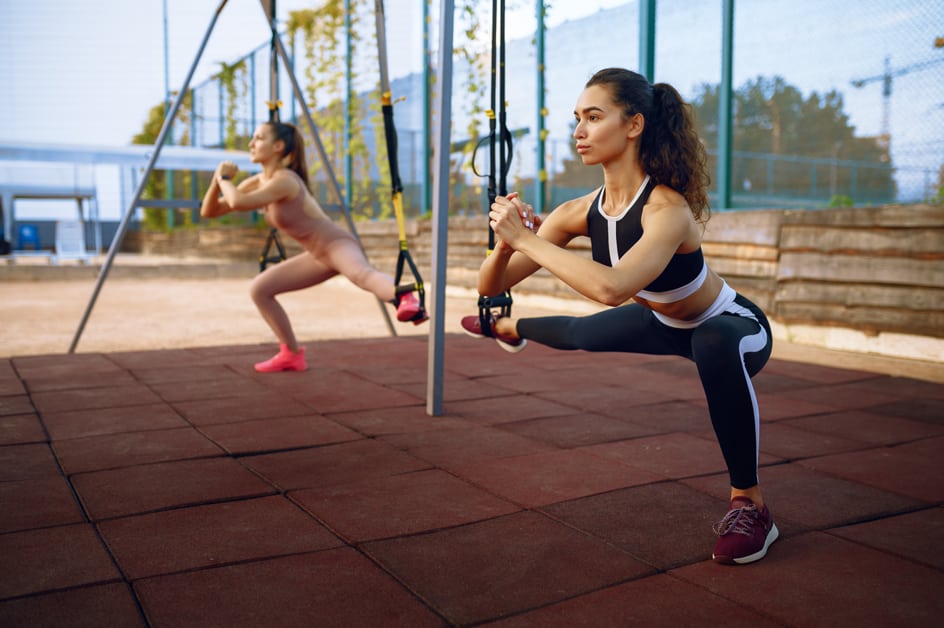Introduction
Yoga is a great way to improve balance, reduce knee pain and increase overall health. Consistent yoga practice can boost stamina, flexibility and muscle tone. Plus, it can enhance your posture, internal organs, breathing and mental clarity.
There are particular yoga poses that help with balance and knee pain. These poses not only improve balance and reduce joint inflammation, but they also strengthen the muscles and tendons around the joint.
It’s very important for those with chronic knee issues to build strength around the joint to reduce stress. Incorporating specific yoga poses into your routine can also reduce inflammation in muscles around the knee and increase range of motion in the joint.
To get results fast, use correct form alignment and focus on controlling your breath while doing the poses. Be consistent and you’ll feel the difference!
Benefits of Balance Training
Balance training is great for improving coordination, strength, posture, and stability. It is especially beneficial for those recovering from an injury or with chronic knee pain. Yoga is the ideal activity for balance training as poses require focus, control, and coordination.
Regular practice can help strengthen muscles around the joint and improve mobility over time. Balance training is an awesome way to improve your fitness level while also protecting against future injuries by strengthening stabilizing muscles.
Incorporating yoga poses that focus on stability allow you to develop better control of balancing. These poses will also build strength in the ankles and feet, as well as create better alignment in the hips and knees to reduce potential injuries and pain.
Here are some effective yoga poses to target knee pain relief through balance training:
- Tree Pose
- Half Moon Pose
- Warrior III
- Dancer’s Pose
- Crescent Lunge
Basic Balance Poses
Balance poses can enhance coordination, flexibility, and agility. They are also a great part of your yoga practice. With balance poses, you can gain a better understanding of your body. Additionally, they are helpful for bolstering your core and giving relief to knee pain.
Here are some basic yoga poses that can help you grow in balance, core strength, and ease knee pain:
Tree Pose
The Tree Pose is a great posture for yoga! It strengthens legs and helps balance. It also opens hips, stretches knees, and supports feet. It’s perfect for those with knee pain and for those wanting to improve their balance.
Start by standing tall, feet hip-width apart. Then, bring your hands together in prayer and take a few moments to settle. Lift one foot off the ground, bend the knee, and place the sole of the foot either along the inner leg or above the ankle.
Engage the lifted leg, like lifting energy up through a tree trunk and its branches. Stand upright on two connected legs. Then, extend arms up towards the sky and hold for five breaths. Release with control and repeat three times.
For a challenge, elevate onto a block or add arm movements!
Warrior III Pose
Warrior III Pose is a balancing, grace-filled pose. It needs strength in the legs and core.
Stand on one foot, with the other leg straight behind you. Reach your arms forward, parallel to the ground.
- Inhale and stand on one foot.
- Exhale and hinge at the hips, extending your arms. Engage your core and press strongly from the standing leg. Make sure the hip is ‘square’.
- Keep your neck length and lift through your chest. Arch back slightly for stability.
- Imagine a line from your toe to your finger tips.
- Take time to explore balance in your side body.
- Return to standing with an inhale breath.
- Consciously bring attention to each movement. This will increase physical benefits, while calming down your system.
Half Moon Pose
Half Moon Pose (Ardha Chandrasana) is an intermediate-level standing balance yoga asana. It offers many benefits to the body and mind. It is a great one-legged posture for increasing strength and flexibility.
To do this pose correctly, attention to detail is key. One must have the ability to stay balanced on one leg. When done right, Half Moon Pose strengthens core muscles, quads, and outer hip muscles. It also improves balance and concentration, increases hip and shoulder mobility, stretches the groin and hamstrings, lengthens spinal extensors, helps improve posture, and relieves stress.
Start in Mountain Pose or Tadasana. Feet can either be together or hip-width apart. Inhale and bring arms up overhead with palms facing each other. Exhale and fold forward from hips, keeping a long spine until fingertips touch toes or a comfortable spot on the floor (like blocks or a bolster).
Inhale and bend the right knee, bringing the right foot off the floor and parallel to the left foot. Exhale and press through the left heel, bringing hands together at heart center with palms facing each other.
Inhale and bring arms out to the sides, staying in a low lunge position. Ensure shoulders are away from ears. Exhale and externally rotate the right femur, extending the heel toward the sky. Keep fingers wide enough apart so that when the right arm reaches the sky, you can look down at the floor beneath your thumbs without bending the elbow.
Inhale and lift up the hips off the left thigh, pressing through the back heel and lifting the torso toward the sky. Palms should be touching the chest, with shoulders near the ears. Inhale and head back, keeping the neck straight and looking forward. Draw energy up from the earth and crown of the head. Rotate the torso slightly and contour the gaze in the opposite direction.
Continue the stretch and come back down into Warrior’s Three Twist. Inhale and lift the gaze, looking outside. Fingers should arch toward the sky. Open the chest as you turn the spine, summoning stability by engaging the legs. Drop the head and pull through the elbows, adjusting the height to allow the torso to form a half moon shape. Hold this pose for a few moments and then release down, keeping a grip along the sides. Step down into lunge, taking time to adjust. When ready, prepare for the opposite movement. Raise the torso when stepping side to side. Step the left foot forward. Join the two feet and come to rest in Savasna.
Chair Pose
Chair Pose (Utkatasana) is a pose with benefits. It strengthens and stretches all major muscle groups. Plus, regular practice brings improved focus and breathing. Traditionally, it helps those with knee issues.
To do Chair Pose:
- Stand upright with feet together.
- Reach overhead with arms.
- Sink your hips back like sitting in an invisible chair.
Points to remember:
- Look down.
- Engage your core.
- Press shoulder blades.
- Press heels and lift arches.
- Stretch arms straight above head. Palms can face in or up.
Advanced Balance Poses
Balance training? Imperative for yoga. Advanced poses? Enhance your balance and stability. Moreover, certain poses? Help soothe knee pain. This article? Reveals the more advanced balance poses and how they can alleviate knee pain. Done!
Eagle Pose
Eagle Pose (Garudasana) is an intermediate yoga posture. It helps improve balance, concentration, and strength. It can also be used to ease knee pain.
Begin in a standing position with your feet slightly apart. Your arms should be raised in the shape of an eagle’s wingspan. Wrap your left arm around your right arm. Your thumbs should be grasping one another’s biceps or triceps.
Next, do small hops from side to side – with both feet off the ground – while breathing deeply. As you gain strength and confidence, you can move onto more advanced variations. This includes hip flexibility and complicated stretches.
More challenging poses like Flying Pigeon and Flying Splits combine elements of Eagle Pose with splits asanas. Mastering Eagle Pose can open up a world of possibilities for your yoga practice.
Crow Pose
Crow Pose (Bakasana) is an advanced balancing pose. It should be practiced with care. Start in a squatting position, tuck your toes, spread your legs slightly and place your arms between your legs. Push your palms into the floor and lift your feet off the ground. This requires strength in the arms, core, hips and legs. With practice, Crow Pose can open your shoulders and chest while strengthening your core muscles.
Warm up with poses like Cat-Cow or Downward Dog. Place your fingertips on either side of your feet for support. Hover your chest above your thighs. Press your torso away from your thighs and lift your feet off the ground. Shift your weight forward over your palms, head and shoulders. Inhale deeply as you lift your feet higher. Exhale deeply when bringing your feet back down. Hold yourself up in this pose and let go of physical or emotional tension in order to maintain balance.
Headstand
Headstand is an advanced yoga pose. It requires strong core stability, full-body coordination and balance. Practicing this pose often may improve wellbeing.
Before attempting headstand, ensure you are ready. This means mastering prerequisite poses like downward facing dog and chaturanga dandasana.
- Start by standing up tall. Inhale and move feet closer to hands. Make an inverted “V” shape with straight legs. Engage your core muscles. Interlace fingers firmly. Place hands below neck/head.
- Lift legs up towards sky. Create a tight Swiss ball like connection throughout the body. Relax shoulders away from ears. Disperse weight across floor. Execute pose with focus and mindfulness.
Knee Pain Relief Poses
Knee pain is a common issue for a lot of folks. To provide relief from this pain, certain yoga poses can be used. We’ll go over the optimum poses for knee pain relief and balance training.
- Standing and seated poses can both help.
Reclining Hero Pose
Reclining Hero Pose is great for easing knee aches. To do it, sit on the floor with your knees bent, feet on the ground, about hip-width apart. Lower yourself until you’re sitting on your heels. Place a cushion or blanket under your head, if needed. Press your legs firmly together. Put your hands at your sides. Remain there for 10 breaths. Focus on inhaling deeply and releasing each muscle from your feet up to your neck and head as you exhale.
To get out, roll onto one side in a fetal position, then gently go back up into a seated position.
Seated Forward Bend
Sit down with feet together and slightly bent. Keep your back straight and head level. Bend forward from waist, reach down without straining. Hold pose for a few breaths. Release. Repeat if needed.
Adding weights while doing this pose can make it more effective. But, consult an instructor or health professional before attempting any weighted poses if you have knee pain.
Half Pigeon Pose
Half Pigeon, or Ardha Kapotasana, relieves knee pain. It loosens tight hip muscles that cause knee tightness and pain. It also strengthens and builds balance in the limbs.
To get into Half Pigeon:
- Sit with legs extended.
- Bend right leg so ankle near left hip. Make sure both hips even on floor.
- Take hold of right foot. Slowly straighten right leg as far as comfortable. Keep both hips even on floor.
- Hold pose for 5-10 breaths. Carefully transition out of pose. Repeat on other side.
Both knees should be supported by Half Pigeon at least once.
Cow Face Pose
Cow Face Pose (Gomukhasana) is an advanced yoga posture. It increases flexibility and balance and can be used for knee pain relief. It gives a deep stretch to inner thighs, hips, back, chest, shoulders and neck.
Start with left knee bent and stacked over the right knee. Feet should be together behind you. Left foot should point outwards, right foot should stay pointing behind. Put your hands on your knees with right palm facing down and left palm facing up. Reach up and open your arms apart so that your palms meet at shoulder level. Keep feet stacked in position beneath you.
Inhale deeply as you lean slightly forward. Feel a mild stretch in your hips. Exhale forward until palms are pressed against each other. Hold this pose for 30-45 seconds. To come out, take a deep breath in. Lift yourself slightly back up. Release arms away from each other. Finally, release legs down onto mat. Maintain good posture until posture is finished completely.
Conclusion
To sum up, yoga can be a good way to ease knee pain and strengthen the lower body. Everyone’s body is unique, so what works for one person might not work for another. When practicing yoga poses to reduce knee pain and improve balance, it’s always important to listen to your body and move slowly.
If you’re uncertain, find qualified yoga teachers or physical therapists who can help you until you find the best poses for your needs. With regular practice and modifications as needed, you can reduce joint discomfort and build strength in the lower back, legs, hips and other areas of your body.
Frequently Asked Questions
Q1: What are some basic yoga poses for balance training?
A1: Some basic yoga poses for balance training include Tree pose, Warrior III pose, Half-Moon pose, and Eagle pose.
Q2: How can yoga help with knee pain?
A2: Practicing yoga can help with knee pain by strengthening the muscles around the knee joint and improving flexibility. Additionally, yoga poses that focus on balance and alignment can also help relieve knee pain.
Q3: What are some specific yoga poses that can be used to relieve knee pain?
A3: Some specific yoga poses that can be used to relieve knee pain include Half Pigeon pose, Reclining Bound Angle pose, and Chair pose.





